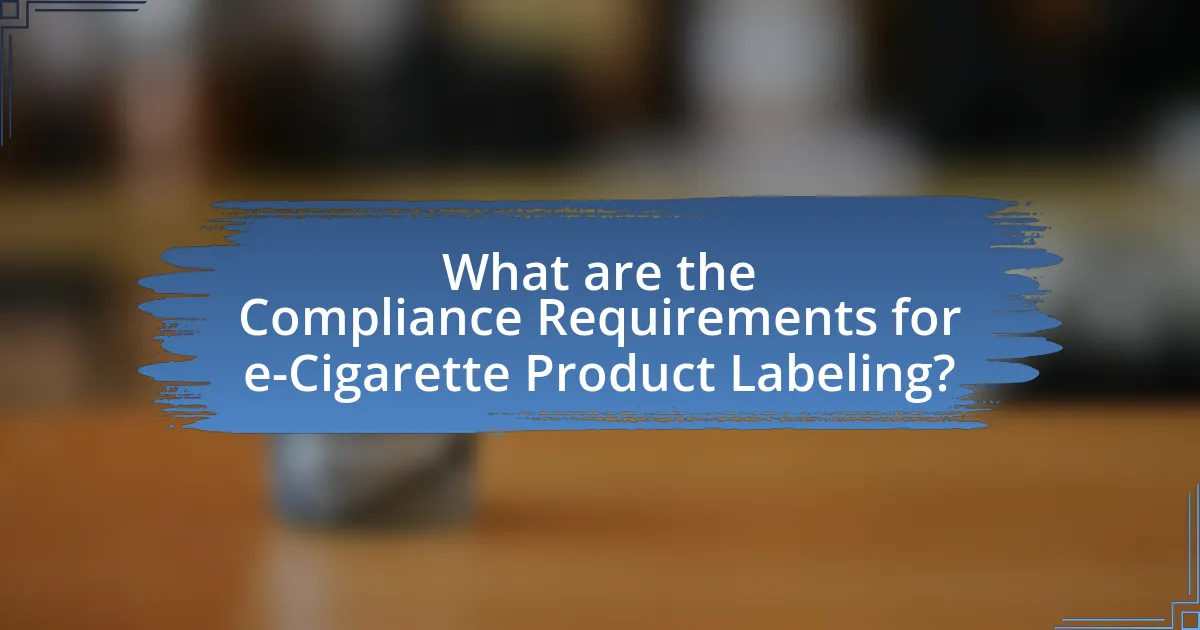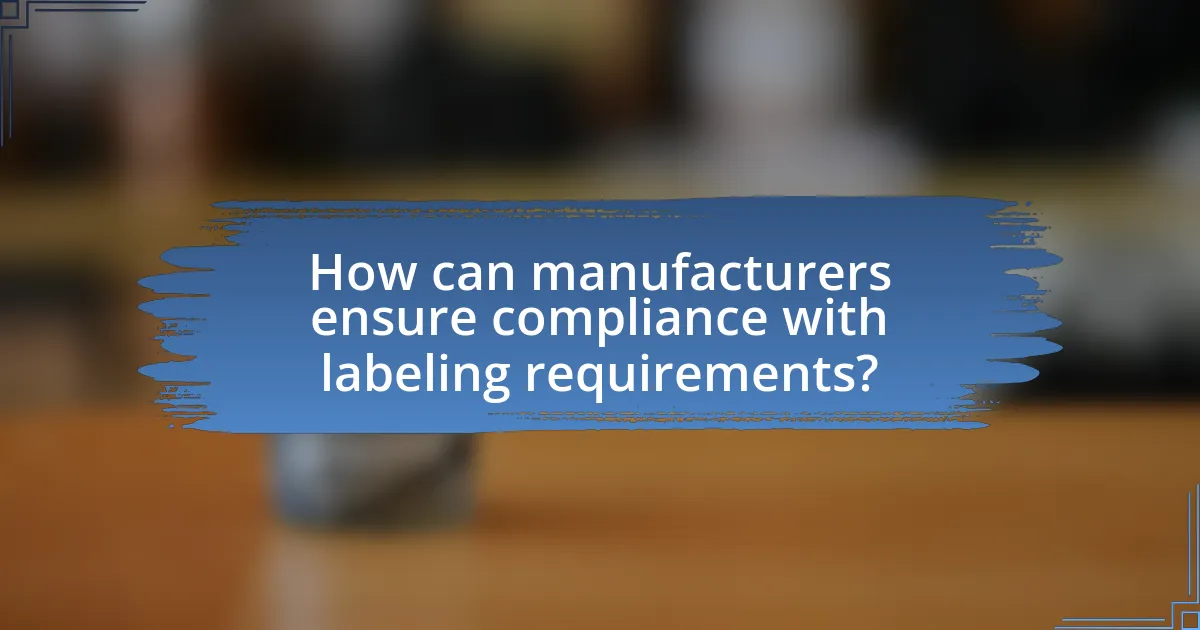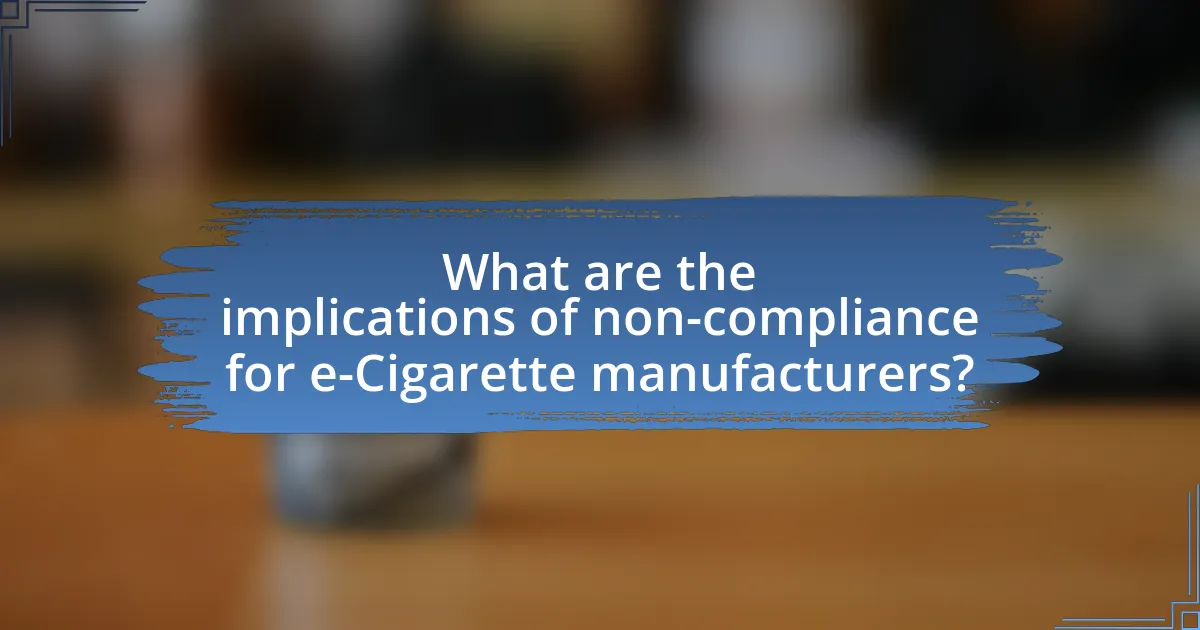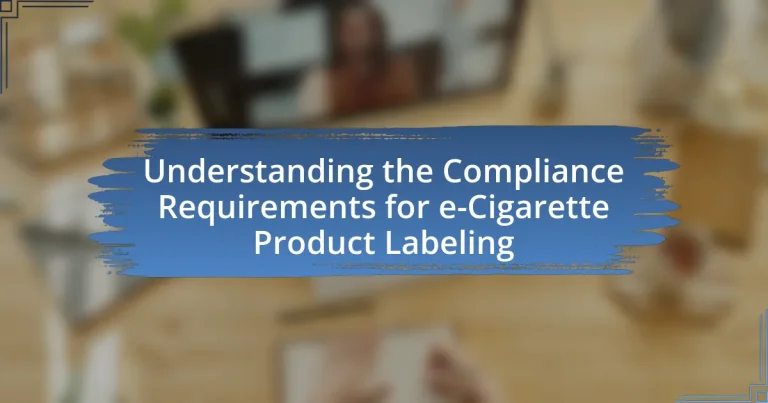The article focuses on the compliance requirements for e-cigarette product labeling, emphasizing the necessity for clear identification as a tobacco product, inclusion of health warnings, and accurate ingredient listings as mandated by the Family Smoking Prevention and Tobacco Control Act. It outlines the importance of compliance for consumer safety, potential consequences of non-compliance, and the role of regulatory bodies such as the FDA and EMA in overseeing labeling standards. Key components of e-cigarette labels, best practices for manufacturers, and the financial and reputational impacts of non-compliance are also discussed, providing a comprehensive overview of the regulatory landscape governing e-cigarette products.

What are the Compliance Requirements for e-Cigarette Product Labeling?
The compliance requirements for e-cigarette product labeling include clear identification of the product as a tobacco product, inclusion of health warnings, and listing of ingredients. The Family Smoking Prevention and Tobacco Control Act mandates that e-cigarette labels must display specific warnings about the risks of nicotine and tobacco use. Additionally, the labels must not contain misleading information and should adhere to the guidelines set forth by the Food and Drug Administration (FDA), which includes providing a statement of the product’s nicotine content. Compliance with these requirements is essential to ensure consumer safety and to meet regulatory standards.
Why is compliance important for e-Cigarette product labeling?
Compliance is important for e-Cigarette product labeling because it ensures that manufacturers adhere to regulatory standards, which helps protect consumer health and safety. Regulatory bodies, such as the FDA in the United States, mandate specific labeling requirements to provide consumers with essential information about the product’s ingredients, nicotine content, and potential health risks. Non-compliance can lead to legal penalties, product recalls, and damage to brand reputation, as evidenced by the FDA’s enforcement actions against companies that fail to meet labeling standards. Therefore, compliance not only safeguards public health but also maintains market integrity and consumer trust.
What are the potential consequences of non-compliance?
The potential consequences of non-compliance with e-cigarette product labeling requirements include legal penalties, financial losses, and reputational damage. Regulatory bodies, such as the FDA, can impose fines or sanctions on companies that fail to adhere to labeling standards, which can reach thousands of dollars per violation. Additionally, non-compliance can lead to product recalls, resulting in significant financial losses for manufacturers. Furthermore, companies may suffer reputational harm, as consumers increasingly prefer brands that demonstrate compliance and responsibility, potentially leading to decreased sales and market share.
How does compliance impact consumer safety?
Compliance significantly enhances consumer safety by ensuring that products meet established health and safety standards. In the context of e-cigarette product labeling, compliance with regulations such as the Tobacco Control Act mandates accurate ingredient disclosure and health warnings, which inform consumers about potential risks. For instance, the FDA’s enforcement of labeling requirements helps prevent misleading claims about e-cigarettes, thereby reducing the likelihood of consumer exposure to harmful substances. Studies indicate that clear labeling can lead to more informed choices, ultimately promoting safer consumption practices among users.
What regulatory bodies oversee e-Cigarette product labeling?
The regulatory bodies that oversee e-Cigarette product labeling include the U.S. Food and Drug Administration (FDA) and the European Medicines Agency (EMA). The FDA regulates e-Cigarettes under the Family Smoking Prevention and Tobacco Control Act, which mandates specific labeling requirements to ensure consumer safety and product transparency. In the European Union, the EMA enforces regulations under the Tobacco Products Directive, which also outlines labeling standards for e-Cigarettes. These agencies ensure compliance with health and safety standards, thereby protecting public health.
What role does the FDA play in e-Cigarette labeling compliance?
The FDA is responsible for regulating e-Cigarette labeling compliance to ensure that manufacturers provide accurate and truthful information about their products. This includes enforcing requirements for health warnings, ingredient listings, and marketing claims, as outlined in the Tobacco Control Act. The FDA conducts inspections and can take enforcement actions against companies that fail to comply with these labeling regulations, thereby protecting public health and ensuring consumers are informed about the risks associated with e-Cigarettes.
Are there other organizations involved in regulating e-Cigarette products?
Yes, other organizations are involved in regulating e-Cigarette products. In addition to the U.S. Food and Drug Administration (FDA), which oversees the regulation of tobacco products, including e-Cigarettes, the Centers for Disease Control and Prevention (CDC) plays a role in public health monitoring and research related to vaping. Furthermore, the Federal Trade Commission (FTC) regulates advertising practices for e-Cigarettes to prevent misleading claims. State and local health departments also implement regulations that can vary significantly, adding another layer of oversight. These organizations collectively contribute to the regulatory framework governing e-Cigarette products.
What are the key components of e-Cigarette product labels?
The key components of e-Cigarette product labels include the product name, nicotine content, ingredients, health warnings, and manufacturer information. These elements are essential for compliance with regulations set by authorities such as the FDA, which mandates that labels must clearly indicate the presence of nicotine and any harmful substances. Additionally, health warnings must be prominently displayed to inform consumers about the risks associated with e-Cigarette use. Accurate manufacturer information ensures traceability and accountability, which are critical for consumer safety and regulatory compliance.
What information must be included on e-Cigarette labels?
e-Cigarette labels must include the following information: the name and address of the manufacturer, a list of ingredients, the nicotine content, health warnings, and any relevant regulatory compliance statements. The inclusion of the manufacturer’s name and address ensures traceability and accountability, while the ingredient list provides transparency regarding the substances contained in the product. Nicotine content is crucial for informing consumers about the product’s potency, and health warnings are mandated to inform users of potential risks associated with e-cigarette use. Regulatory compliance statements confirm adherence to applicable laws and regulations, ensuring consumer safety and product legitimacy.
How should nicotine content be displayed on labels?
Nicotine content should be displayed on labels in a clear and prominent manner, typically expressed in milligrams per milliliter (mg/mL) for liquid products. This standardization allows consumers to easily understand the strength of nicotine in the product they are purchasing. Regulatory guidelines, such as those from the U.S. Food and Drug Administration (FDA), mandate that nicotine levels must be accurately represented to ensure consumer safety and informed choices. Accurate labeling helps prevent misuse and supports compliance with public health regulations.

How can manufacturers ensure compliance with labeling requirements?
Manufacturers can ensure compliance with labeling requirements by thoroughly understanding and adhering to the regulations set forth by governing bodies such as the Food and Drug Administration (FDA) in the United States. This involves conducting regular reviews of labeling guidelines, which include specific information that must be displayed, such as health warnings, ingredient lists, and nicotine content. For instance, the FDA mandates that e-cigarette products must include a warning statement about the addictive nature of nicotine, as outlined in the Family Smoking Prevention and Tobacco Control Act. Additionally, manufacturers should implement a compliance management system that includes training for staff on labeling laws, regular audits of product labels, and consultation with legal experts to stay updated on any changes in regulations.
What steps should manufacturers take to meet compliance standards?
Manufacturers should conduct a thorough review of applicable regulations to meet compliance standards for e-cigarette product labeling. This involves understanding federal, state, and local laws governing e-cigarette products, including the Family Smoking Prevention and Tobacco Control Act and the FDA’s regulations. Manufacturers must ensure that all product labels include required information such as health warnings, ingredient lists, and nicotine content. Additionally, they should implement quality control measures to verify that labeling is accurate and consistent with regulatory requirements. Regular audits and training for staff on compliance standards further reinforce adherence to these regulations.
How can manufacturers stay updated on changing regulations?
Manufacturers can stay updated on changing regulations by actively monitoring industry-specific regulatory bodies and subscribing to relevant newsletters. Regulatory bodies such as the Food and Drug Administration (FDA) and the European Medicines Agency (EMA) frequently publish updates on compliance requirements, including those related to e-cigarette product labeling. Additionally, joining industry associations, such as the Vapor Technology Association, provides access to resources and updates on legislative changes. Engaging with legal experts who specialize in regulatory compliance can also ensure that manufacturers are informed about new laws and amendments that may affect their products.
What resources are available for compliance assistance?
Resources available for compliance assistance in e-cigarette product labeling include the U.S. Food and Drug Administration (FDA) guidelines, which provide detailed information on labeling requirements. The FDA’s website offers access to compliance manuals, regulatory guidance documents, and FAQs specifically tailored for manufacturers and retailers of e-cigarette products. Additionally, industry associations such as the Vapor Technology Association (VTA) and the American Vaping Association (AVA) provide resources, including webinars and workshops, to help businesses understand and navigate compliance obligations. These resources are essential for ensuring adherence to federal regulations and avoiding potential penalties.
What common mistakes do manufacturers make regarding compliance?
Manufacturers commonly make mistakes regarding compliance by failing to fully understand and implement the specific labeling requirements mandated by regulatory bodies. For instance, many manufacturers neglect to include all required health warnings and ingredient disclosures on e-cigarette packaging, which can lead to significant legal penalties. According to the U.S. Food and Drug Administration (FDA), non-compliance with labeling regulations can result in product recalls and fines, emphasizing the importance of adhering to established guidelines. Additionally, manufacturers often overlook the need for regular updates to their labeling practices in response to changing regulations, further compounding compliance issues.
How can these mistakes be avoided?
To avoid mistakes in e-cigarette product labeling compliance, manufacturers should implement a systematic review process that includes regular audits of labeling against regulatory requirements. This process ensures that all claims, warnings, and ingredient disclosures meet the standards set by the Food and Drug Administration (FDA) and other relevant authorities. For instance, the FDA mandates specific health warnings and ingredient listings, and failure to comply can result in significant penalties. By establishing a compliance checklist and training staff on current regulations, companies can minimize errors and ensure adherence to legal standards.
What are the best practices for e-Cigarette labeling compliance?
The best practices for e-Cigarette labeling compliance include ensuring that labels contain accurate product information, health warnings, and ingredient lists as mandated by regulatory authorities. Compliance with the Family Smoking Prevention and Tobacco Control Act requires that e-Cigarette labels display a prominent warning about the addictive nature of nicotine. Additionally, labels must not make misleading claims about health benefits or risks associated with the product. Adhering to state-specific regulations, which may impose additional requirements, is also essential. Regular audits and updates to labeling practices in response to changing regulations help maintain compliance.

What are the implications of non-compliance for e-Cigarette manufacturers?
Non-compliance for e-Cigarette manufacturers can lead to severe legal and financial repercussions. Manufacturers may face substantial fines imposed by regulatory bodies, which can reach millions of dollars depending on the severity of the violation. Additionally, non-compliance can result in the revocation of licenses to operate, effectively halting business activities.
Furthermore, e-Cigarette products that do not meet labeling requirements may be subject to recalls, leading to loss of consumer trust and damage to brand reputation. For instance, the FDA has enforced strict regulations under the Tobacco Control Act, and failure to adhere to these can result in enforcement actions that disrupt market access.
In summary, the implications of non-compliance encompass financial penalties, operational disruptions, and reputational harm, all of which can significantly impact the sustainability of e-Cigarette manufacturers in a highly regulated market.
What legal actions can be taken against non-compliant manufacturers?
Legal actions against non-compliant manufacturers include fines, product recalls, and legal injunctions. Regulatory bodies, such as the Food and Drug Administration (FDA) in the United States, can impose monetary penalties for violations of compliance requirements related to e-cigarette product labeling. For instance, the FDA has the authority to issue warning letters and initiate enforcement actions that may lead to civil penalties or criminal charges if manufacturers fail to adhere to established regulations. Additionally, non-compliant products may be subject to mandatory recalls to protect public health, as seen in various cases where unsafe products were removed from the market to prevent harm.
How can non-compliance affect a brand’s reputation?
Non-compliance can severely damage a brand’s reputation by leading to legal penalties, loss of consumer trust, and negative media coverage. For instance, brands that fail to adhere to e-cigarette product labeling regulations may face fines and sanctions from regulatory bodies, which can publicly tarnish their image. Additionally, consumers are increasingly aware of compliance issues; a survey by the American Vaping Association found that 70% of consumers would avoid brands associated with non-compliance. This erosion of trust can result in decreased sales and long-term brand loyalty issues, as consumers prefer to support companies that demonstrate responsibility and adherence to regulations.
What are the financial impacts of non-compliance?
Non-compliance with e-cigarette product labeling requirements can lead to significant financial impacts, including hefty fines, legal costs, and loss of market access. Regulatory bodies, such as the FDA, impose penalties that can reach millions of dollars for violations, which directly affects a company’s financial health. For instance, in 2021, the FDA issued fines totaling over $1.5 million against companies for non-compliance with labeling regulations. Additionally, non-compliance can result in increased operational costs due to the need for corrective actions, such as re-labeling products or implementing compliance programs. Furthermore, companies may face reputational damage, leading to decreased sales and market share, as consumers increasingly prefer compliant brands.
How can fines and penalties affect a manufacturer’s bottom line?
Fines and penalties can significantly reduce a manufacturer’s bottom line by imposing direct financial costs and indirect operational impacts. For instance, a manufacturer found in violation of e-cigarette product labeling regulations may face fines that can range from thousands to millions of dollars, depending on the severity of the violation. Additionally, these financial penalties can lead to increased scrutiny from regulatory bodies, resulting in higher compliance costs and potential disruptions in production. According to the FDA, non-compliance with labeling requirements can also lead to product recalls, which further erode profit margins and damage brand reputation. Thus, the financial implications of fines and penalties extend beyond immediate costs, affecting overall profitability and market position.
What practical tips can manufacturers follow to ensure compliance?
Manufacturers can ensure compliance with e-cigarette product labeling requirements by implementing a systematic approach to adhere to regulations. First, they should familiarize themselves with the specific labeling laws set forth by regulatory bodies such as the FDA, which mandates that labels must include health warnings, ingredient lists, and manufacturer information. Additionally, manufacturers should conduct regular audits of their labeling practices to identify and rectify any discrepancies with current regulations.
Furthermore, training staff on compliance standards and maintaining updated documentation can help prevent violations. Research indicates that companies that invest in compliance training reduce the risk of regulatory infractions by up to 30%. By actively engaging in these practices, manufacturers can effectively navigate the complexities of e-cigarette product labeling compliance.

